
ONE thing is certain about the new-vehicle market: nothing ever stands still for too long. This is especially so in the ultra-competitive ute market, where Nissan and Isuzu have both brought new product.
The Nissan Navara upgrade is entirely voluntary, while the Isuzu D-MAX comes off the back of new government-mandated exhaust emission standards. For the D-MAX, this means significant engine changes and – for good measure – Isuzu has also thrown in a six-speed automatic gearbox to replace the previous five-speed, new cabin features, and revised exterior styling.
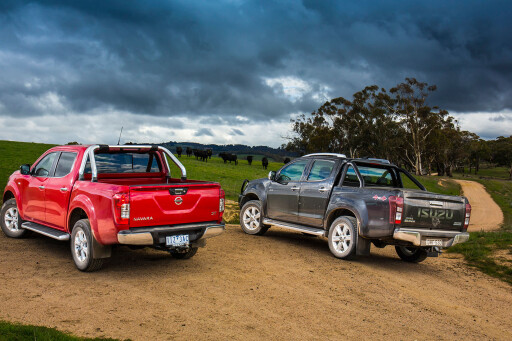 Over at Nissan, the changes to what is a relatively newly designed Navara (2015) bring an additional work-grade model with the more powerful of the two diesel engines, extra kit on some models and a retuning of the suspension.
Over at Nissan, the changes to what is a relatively newly designed Navara (2015) bring an additional work-grade model with the more powerful of the two diesel engines, extra kit on some models and a retuning of the suspension.
Spec level for spec level, these two utes are price comparable – at least in the most popular ST and LS-U spec levels – so we decided to line them up side by side to see how they compare.
NISSAN NAVARA ST SERIES II
JUST two years after it arrived, Nissan’s new-generation NP300 Navara has undergone a makeover to become the Series II.
When the Navara NP300 arrived it 2015, it was a rule breaker. On all but the base RX model, coil springs replaced leaf springs – the ute staple rear end – in what was potentially a game-changing move. In another significant departure from standard class practice, on most models the Navara adopted a relatively small diesel engine with two turbos rather than one. Before the Navara arrived, only the Amarok had this feature in a ute. Also distinguishing the Navara from the pack was its seven-speed automatic gearbox.
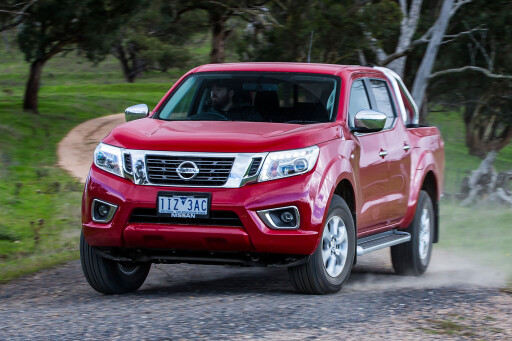 Sales-wise, the NP300 Navara hasn’t really worked for Nissan, failing to emulate the success of the D40 Navara, which, in its heyday, was second only to the all-conquering Toyota Hilux. In 2016, the NP300 was, in fact, outsold by the Hilux and the Ford Ranger by more than two to one, and it also fell behind both the Mitsubishi Triton and the Holden Colorado in overall sales.
Sales-wise, the NP300 Navara hasn’t really worked for Nissan, failing to emulate the success of the D40 Navara, which, in its heyday, was second only to the all-conquering Toyota Hilux. In 2016, the NP300 was, in fact, outsold by the Hilux and the Ford Ranger by more than two to one, and it also fell behind both the Mitsubishi Triton and the Holden Colorado in overall sales.
Here at 4X4 Australia we weren’t great fans of the NP300 as a general purpose on- and off-road ute, and we were particularly unimpressed by the way it performed in our seven-ute, maxxed-out load and tow test comparison conducted last year.
Fast forward to 2017 and Nissan has headed back to the drawing board with a suspension revamp, spec and equipment changes, and the addition of a new work-spec model (the SL) that has the bi-turbo engine, rear coils, and sits above the leaf-sprung, single-turbo RX. Nissan also has also dropped NP300 moniker, so the new model is simply called the Navara Series II.
Powertrain and performance
THE Renault-sourced 2.3-litre four-cylinder diesel has, as mentioned, two turbos rather than one. This is reasonably common with European-design diesel engines and involves a smaller turbo that works off idle and under small loads coupled with a larger turbo that takes over as the engine speeds and loads increase. This arrangement offers quick low-rpm response combined with good power at higher engine speeds – two ideals that are hard to achieve with a single turbo.
 The result on paper – 140kW and 450Nm – is what you’d expect of a larger capacity diesel, and the Navara delivers on-road thanks to this and other attributes including the relatively close ratios of its seven-speed automatic. Throw in the Navara being one of the lightest utes of the current crop – and one that runs lower overall gearing than most (top gear gives around 55km/h/100km) – and there’s plenty of performance on offer. In fact, when we last ran the current crop of utes against the clock, the Navara was the quickest in the 80-120km/h sprint; although, the Holden Colorado, which has since been revised, may now do better.
The result on paper – 140kW and 450Nm – is what you’d expect of a larger capacity diesel, and the Navara delivers on-road thanks to this and other attributes including the relatively close ratios of its seven-speed automatic. Throw in the Navara being one of the lightest utes of the current crop – and one that runs lower overall gearing than most (top gear gives around 55km/h/100km) – and there’s plenty of performance on offer. In fact, when we last ran the current crop of utes against the clock, the Navara was the quickest in the 80-120km/h sprint; although, the Holden Colorado, which has since been revised, may now do better.
Fuel-use labels are riddled with problems
The Navara’s engine is generally quiet, except at wide throttle openings where it becomes noticeably noisier. For its part, the seven-speed auto adds to the general driveline refinement with smooth and quick shifts; although, it tends to grab a taller gear more often than you may want in give-and-take conditions, perhaps because the shift protocols are tuned more towards economy rather than performance. And, speaking of economy, the Navara has an excellent ADR figure of just 7.0L/100km, but it’s less distinguished on the road with a figure of 11.5L/100km for this test.
On-road ride and handling
SUSPENSION changes have resulted in much better on-road steering and handling. Gone is the too-heavy steering, while the front-to-rear suspension match is also much improved. You may think coil springs would provide a more supple ride than the leaf springs fitted to competitor utes, but this isn’t the case. If anything, the Navara rides more firmly than before – and certainly no better than competitor utes – but getting the front-to-rear balance right has made the change to a firmer and crisper ride one for the better.
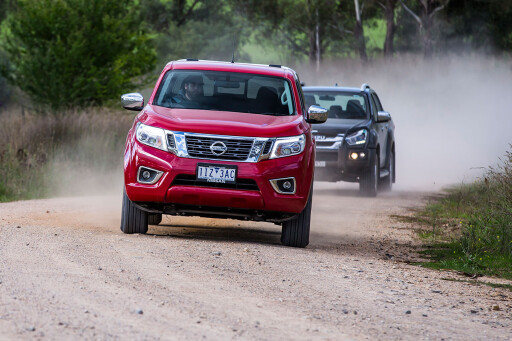 A positive of the Navara’s rear suspension, when compared to its leaf-spring competitors, is less axle tramp when accelerating through and out of bumpy and corrugated corners.
A positive of the Navara’s rear suspension, when compared to its leaf-spring competitors, is less axle tramp when accelerating through and out of bumpy and corrugated corners.
Off-road
THE two top-spec Navaras come standard with a rear locker and, like the lockers on the Ford Ranger and Volkswagen Amarok automatic, engaging the locker doesn’t cancel electronic traction control (ETC) across the front axle. This is a notable positive and helps improve the Navara’s performance in gnarly conditions; whereas lockers that cancel ETC across both axles often don’t bring an improvement.
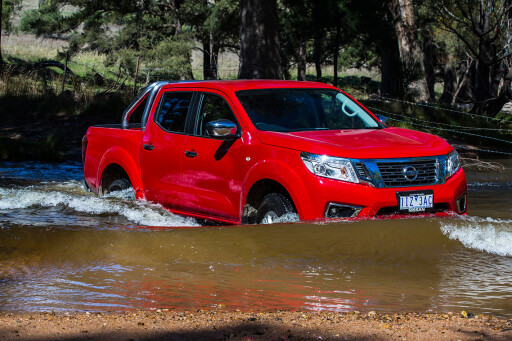 That said, the Navara is still no off-road hero compared to the likes of the class leaders – Ranger, Hilux and Amarok – due in part to the fact it doesn’t have comparable wheel travel and it rides a little lower than most in its class. The Navara’s over-bonnet vision does no favours off-road, either, and shorter drivers in particular will find themselves wishing to sit a little higher.
That said, the Navara is still no off-road hero compared to the likes of the class leaders – Ranger, Hilux and Amarok – due in part to the fact it doesn’t have comparable wheel travel and it rides a little lower than most in its class. The Navara’s over-bonnet vision does no favours off-road, either, and shorter drivers in particular will find themselves wishing to sit a little higher.
On a more positive note, the shift protocols of the seven-speed work well off-road, and there’s a notably low crawl ratio.
Cabin, accommodation and safety
WITH no less than seven airbags, Navara dual cab utes offer five-star ANCAP safety in a modern car-like cabin that’s generally comfortable up front but smaller than most across the rear seat. Of the current mainstream utes, only the Mitsubishi Triton has a smaller rear seat. No reach adjustment for the steering wheel, either; although, this is unfortunately the case more often than not with this class of vehicle.
 Two things worth noting is that the top-spec ST-X offers a sunroof as an option (previously standard), a unique feature in this class of vehicle. The centre panel of the Navara’s rear window can also be opened and, while this may seem like a why-bother feature, it improves cabin ventilation without adding the wind buffeting you typically get when opening a rear side window.
Two things worth noting is that the top-spec ST-X offers a sunroof as an option (previously standard), a unique feature in this class of vehicle. The centre panel of the Navara’s rear window can also be opened and, while this may seem like a why-bother feature, it improves cabin ventilation without adding the wind buffeting you typically get when opening a rear side window.
Practicalities
THE Navara’s 3500kg tow rating matches the best in class on paper, but when we tow-tested it – before the suspension upgrade – it did a poor job of hauling 3500kg. Likewise, while the Navara has reasonable payload figures, it doesn’t carry a maximum payload well. We won’t know whether the recent upgrade has improved these two aspects until we get a chance to carry out a full load and tow test.
Performax International's Nissan Titan XD debuts
The four fixed tie-downs in the Nissan Navara ST’s tub (ST-X gets adjustable tie-downs) aren’t ideally located either, as they are mounted high on the tub’s sides and not down on the floor where they should be. However, the ST gets a 12-volt outlet in its tub.
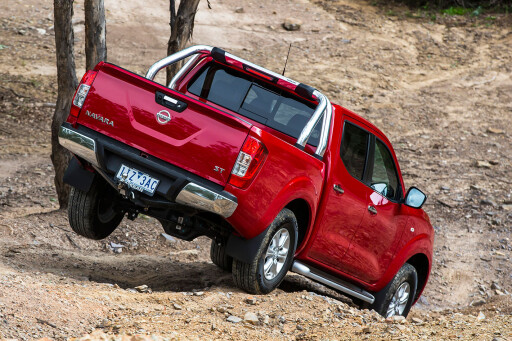 The ST runs 16-inch wheels, which is a bonus in terms of tyre choice and practicality, but, as is usual ute practice, there are no recovery points at the rear and just one at the front. Before you drive off into a creek you should also note the engine’s air intake is behind the bonnet lip, and the claimed wading depth is a very low 450mm – something that would have to be addressed to turn the Navara into a serious 4x4.
The ST runs 16-inch wheels, which is a bonus in terms of tyre choice and practicality, but, as is usual ute practice, there are no recovery points at the rear and just one at the front. Before you drive off into a creek you should also note the engine’s air intake is behind the bonnet lip, and the claimed wading depth is a very low 450mm – something that would have to be addressed to turn the Navara into a serious 4x4.
The Navara comes with a 20,000km service interval, which is longer than most.
What you get: Navara
ALL Navara dual cab 4x4s have ESC, ETC, seven airbags, a six-speaker audio with a CD slot and USB and iPod inputs, Bluetooth, cruise control, and a 12-volt outlet in the rear tub.
Moving up from the RX to the new SL model (replaces DX) nets you the 140kW bi-turbo engine (instead of 120kW single-turbo engine), a rear view camera and LED headlights with DRLs. From there the ST gains 16-inch alloys, seven-inch touchscreen with sat-nav, fogs, side steps, chrome ‘sports bar’ and a rear locker.
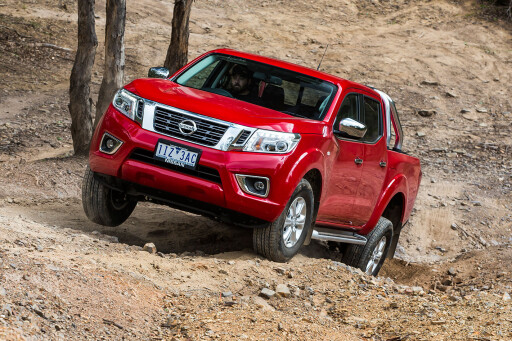 The top-spec ST-X model gains leather seats (heated up front) and electric adjustment for driver’s seat. It also has heated and power-folding door mirrors, rear parking sensors and an optional sunroof, which was previously standard on the ST-X.
The top-spec ST-X model gains leather seats (heated up front) and electric adjustment for driver’s seat. It also has heated and power-folding door mirrors, rear parking sensors and an optional sunroof, which was previously standard on the ST-X.
Nissan Navara II prices*
RX: $47,565
SL: $53,235
ST: $48,865
ST-X: $55,415
*4x4 dual cab pick-up manuals. Automatic adds $2580.
Nissan Navara II ST (dual cab 4x4 auto)
Engine: 2.3-litre 4-cyl bi-turbo-diesel
Max power: 140kW @ 3750rpm
Max torque: 450Nm @ 1500-2500rpm
Gearbox: seven-speed automatic
4x4 System: dual-range part-time
Crawl ratio: 44.6:1
Construction: separate chassis
Front suspension: independent/coil springs
Rear suspension: live axle/coil springs
Kerb weight: 1925kg
GVM: 2910kg
Payload: 985kg
Towing capacity: 3500kg
Towball download (max): 300kg
GCM: 5910kg
Fuel tank capacity: 80 litres
ADR fuel claim: 7.0L/100km
Test fuel use: 11.5L/100km
Touring range*: 645km
*Based on test fuel use, claimed fuel capacity and a 50km ‘safety’ margin.
MY17 ISUZU D-MAX
ISUZU has used new and tougher mandatory exhaust emission standards as a springboard for a raft of upgrades to its faithful D-MAX.
November 2016 saw the introduction of Euro 5 diesel exhaust standards in Australia, replacing the previous Euro 4 standard. What that means is that cars built after November 2016 need to comply with the new standard or they can’t be sold. That’s the law – simple as that.
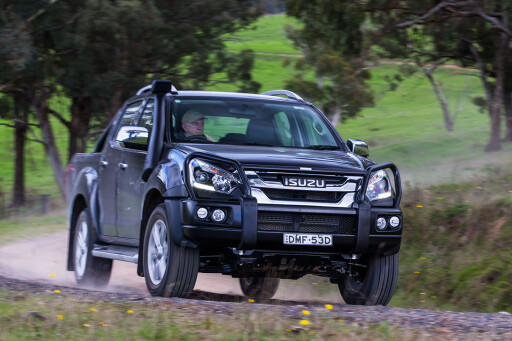 Euro 5 primarily targets particulate matter in the exhaust gas, so it’s no surprise the D-MAX – previously only certified to Euro 4 – gains a diesel particulate filter (DPF); although, this is by no means the only change. In fact, just about everything bar the bottom-end of Isuzu’s long-serving (from 2005) 3.0-litre diesel engine has been updated, with a new-generation higher-pressure common-rail injection, a new variable-geometry low-inertia turbo, a larger EGR cooler and new pistons the key changes.
Euro 5 primarily targets particulate matter in the exhaust gas, so it’s no surprise the D-MAX – previously only certified to Euro 4 – gains a diesel particulate filter (DPF); although, this is by no means the only change. In fact, just about everything bar the bottom-end of Isuzu’s long-serving (from 2005) 3.0-litre diesel engine has been updated, with a new-generation higher-pressure common-rail injection, a new variable-geometry low-inertia turbo, a larger EGR cooler and new pistons the key changes.
2014 Isuzu D-Max vs Isuzu MU-X LS-T
There’s also a new Aisin six-speed automatic replacing the Aisin five-speed. And, as with the outgoing five-speed, the new six-speed is also used by Toyota in the Hilux and Prado and shares ratios including the two – notably tall – overdrives. The rear differential has also been strengthened, but it carries the same final-drive ratio.
Outside of these mechanical changes there’s a new interior with bigger touchscreens – seven or eight-inch (with sat-nav), depending on the model – two extra speakers (now eight) across the dual cab range, and more cabin soundproofing. Exterior changes include lights, bonnet and grille, which contribute to fractionally less aerodynamic drag – according to Isuzu.
Powertrain and performance
DESPITE the raft of engine changes, maximum power remains at a modest 130kW. So, pedal-to-the-metal, the new D-MAX goes about as hard as the old D-MAX, given the new six-speed only adds an extra overdrive for more relaxed highway cruising.
Away from this extreme, the D-MAX’s engine remake provides more driveability with increased torque (430Nm, up from 380Nm), providing more power at low and middle rpm. The ‘fatter’ torque curve means the previous maximum of 380Nm is produced 100rpm lower (now 1700rpm) and extends 700rpm higher (to 3500rpm).
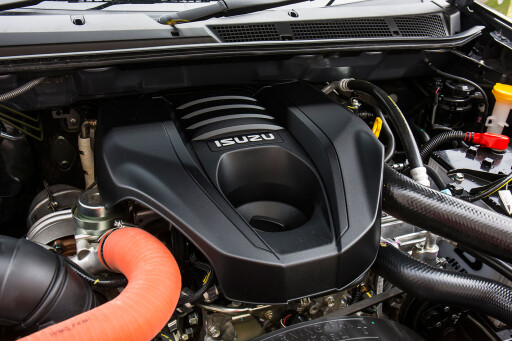 Effectively, what you get is a more responsive engine and a gearbox that does everything better, though it doesn’t give tighter ratios. The shifts are quicker and slicker than before, and new shift protocols mean a more active and sporty approach to gear selection compared to the generally sleepy five-speed. The auto downshifts on descent – with and without brake intervention – are particularly well-timed. The D-MAX carries the two very tall top gears surprisingly well and doesn’t overly shuffle back and forth between them on undulating country roads.
Effectively, what you get is a more responsive engine and a gearbox that does everything better, though it doesn’t give tighter ratios. The shifts are quicker and slicker than before, and new shift protocols mean a more active and sporty approach to gear selection compared to the generally sleepy five-speed. The auto downshifts on descent – with and without brake intervention – are particularly well-timed. The D-MAX carries the two very tall top gears surprisingly well and doesn’t overly shuffle back and forth between them on undulating country roads.
Newhaven Wildlife Sanctuary, Northern Territory
The new common-rail injection system makes the engine quieter than before; although, the D-MAX’s general engine-running refinement isn’t anything special. The fact it’s a ‘big’ four-cylinder by class standards, and it still runs a relatively high 17.3:1 compression ratio, both work against it. By comparison, the 2.8-litre diesel now in the Hilux is smaller in capacity and runs a much ‘softer’ 15.6:1 compression ratio.
The changes have brought a small improvement in the official ADR fuel figure, down from 8.1L/100km to 7.9L/100km for the two respective automatics. On this test, the D-MAX used 12.0L/100km, which was slightly higher than expected given the D-MAX has generally been one of the more economical utes.
On-road ride and handling
AS before, the D-MAX’s suspension provides a decent ride that can be surprisingly comfortable, even when the vehicle is unladen. The front-to-rear suspension match that’s often a problem with utes is also well-sorted. It’s worth noting the LS-T, as tested here – along with the LS-U and SX models – have ‘standard’ rear springs, while the LS-M has ‘heavy duty’ rear springs. Not that it matters much, with only a 25kg difference in payload.
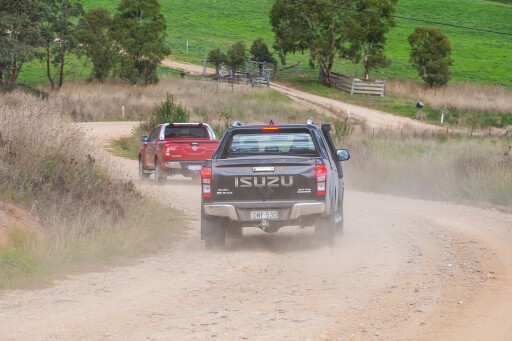 Along with its good front-to-rear suspension match, the D-MAX has a nice, positive steering feel, without having the excellent response and feel of something like the Amarok or Ranger, the class leaders in this regard.
Along with its good front-to-rear suspension match, the D-MAX has a nice, positive steering feel, without having the excellent response and feel of something like the Amarok or Ranger, the class leaders in this regard.
Off-road
THE D-MAX is a little unusual among today’s utes, as it doesn’t come with a rear diff lock. Nor does the chassis provide anything special in the way of wheel travel, so it’s not among the front runners when it comes to more arduous off-road work, especially gnarly hill climbs.
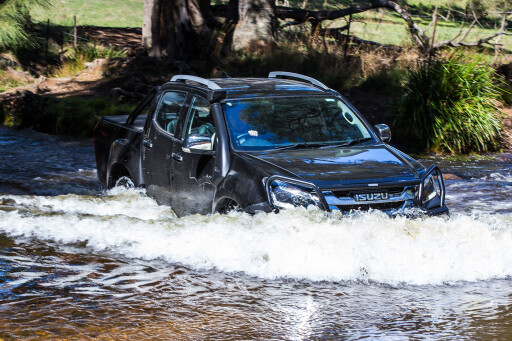 That said, clearance is up there with the best in class, and it has a particularly good driving position in terms of forward visibility. Plus it’s up to most recreational off-road driving, even on the standard tyres.
That said, clearance is up there with the best in class, and it has a particularly good driving position in terms of forward visibility. Plus it’s up to most recreational off-road driving, even on the standard tyres.
Cabin, accommodation and safety
ALL D-MAX dual cabs come with five-star ANCAP safety, thanks to six airbags and mandatory features like electronic stability control.
 In terms of size, the D-MAX’s cabin is bigger than the Hilux, Triton and Navara and matches the Colorado, but it’s not as big as the Ford Ranger, Mazda BT-50 or Volkswagen Amarok. It doesn’t matter for the driver or the front seat passenger, but those in the back will feel the difference, especially when trying to accommodate three adults.
In terms of size, the D-MAX’s cabin is bigger than the Hilux, Triton and Navara and matches the Colorado, but it’s not as big as the Ford Ranger, Mazda BT-50 or Volkswagen Amarok. It doesn’t matter for the driver or the front seat passenger, but those in the back will feel the difference, especially when trying to accommodate three adults.
The new cabin also presents better than before – less commercial and more passenger-car like – but still doesn’t offer tilt-and-reach steering wheel adjustment.
Practicalities
THE D-MAX offers a class-leading 3500kg tow rating and class-competitive payloads, even if its GVM is below the best in class. When subjected to our maxxed-out load and tow test (before this recent upgrade) the chassis coped well but the engine was off the pace; although, no doubt the extra power at low and middle rpm, thanks to the extra torque, will help here.
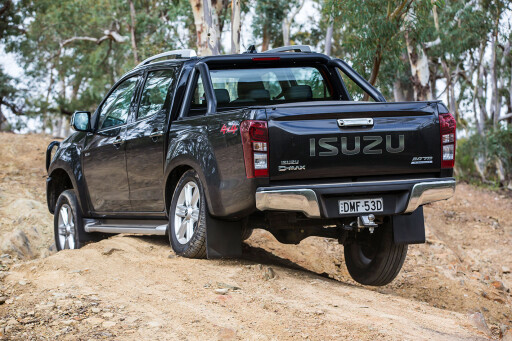 In the tub there are four tie-down hooks – the two at the rear are mounted on the floor where they should be, but the front pair are high-mounted, which is hardly useful unless you’re carrying something tall.
In the tub there are four tie-down hooks – the two at the rear are mounted on the floor where they should be, but the front pair are high-mounted, which is hardly useful unless you’re carrying something tall.
The engine draws its air from the inner mudguard, which is great for fording water. As a bonus, there are two recovery hooks up front and a solid engine protection plate. Under the bonnet there’s also room for a second battery. D-MAX’s also come with fully interchangeable 16-, 17- and 18-inch wheels, so there are plenty of options for replacement tyres.
What you get: D-MAX
ALL D-MAX dual cab 4x4s have ESC, ETC, six airbags, an eight-speaker audio with a CD slot and USB and iPod inputs, Bluetooth and cruise control. Move up to the LS-M from the SX and you get 16-inch alloys (instead of 16-inch steels), projector headlights with DRLs, foglights, two extra USB ports and a reversing camera. From there the LS-U gets 17-inch alloys, an eight-inch (rather than a seven-inch) touchscreen, sat-nav and side steps. The top-spec LS-T, which is auto-only, gains leather, electric adjustment for the driver’s seat, proximity-key entry, push-button start and 18-inch alloys.
Isuzu D-MAX prices*
SX: $43,900
LS-M: $46,400
LS-U: $48,300
LS-T (auto): $54,200
*4x4 dual cab pick-up manuals, unless noted. Automatic adds $2100
Isuzu D-MAX LS-T (crew cab 4x4)
Engine: 3.0-litre 4-cyl turbo-diesel
Max Power: 130kW @ 3600rpm
Max Torque: 430Nm @ 2000-2200rpm
Gearbox: six-speed automatic
4x4 System: dual-range part-time
Crawl ratio: 33.3:1
Construction: separate chassis
Front suspension: independent/coil springs
Rear suspension: live axle/leaf springs
Kerb Weight: 2026kg
GVM: 2950kg
Payload: 924kg
Towing capacity: 3500kg
Towball download (max): 350kg
GCM: 5950kg
Fuel tank capacity: 76 litres
ADR fuel claim: 7.9L/100km
Test fuel use: 12.0L/100km
Touring range**: 534km
**Based on test fuel use, claimed fuel capacity and a 50km ‘safety’ margin.
THE VERDICT
THE Navara and the D-MAX have similar price tags (just north of $50K as an auto, plus on-roads) in the popular one-down-from-the-top model, in this case the ST and LS-U respectively. They also sell in similar numbers on the 4x4 ute market, the Navara in fifth and the D-MAX in sixth place – behind the Hilux, Ranger, Triton and Colorado, but ahead of the BT-50 and Amarok.
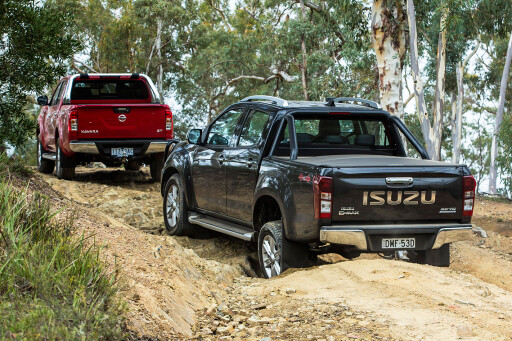 Despite these similarities, drive the two back-to-back and there’s a world of difference. The Navara feels more refined, nippier, smaller and sportier – and more car-like and less ute-like. The D-MAX counters with a bigger, roomier cabin, a better ride on rough roads, and what should be a better load and towing ability, unless the Navara’s suspension changes make a big difference in that role – something that still needs to be tested.
Despite these similarities, drive the two back-to-back and there’s a world of difference. The Navara feels more refined, nippier, smaller and sportier – and more car-like and less ute-like. The D-MAX counters with a bigger, roomier cabin, a better ride on rough roads, and what should be a better load and towing ability, unless the Navara’s suspension changes make a big difference in that role – something that still needs to be tested.
Off-road these two are closer and, while the Navara’s rear diff-lock is a bonus on something like a rutted and rocky climb, the D-MAX’s extra clearance, better driving position and deeper fording ability make it the better 4x4 proposition.

COMMENTS